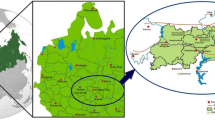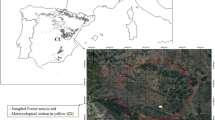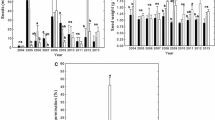Abstract
Lack of information and difficulty in predicting wild edible sporocarp yields is blocking its integration in forest management. In the Mediterranean area, this nontimber forest product has increased its market value, consumption demand, and interest over the last decade. In this work, sampling year and stand age effects are analyzed in order to advance knowledge of edible fungi community structure, dynamics, and production. Weekly autumnal sporocarp monitoring was performed from 1997 to 2011 in a Pinus pinaster managed forest in central Spain. After applying a random stand age-stratified survey, 21 plots of 150 m2 have been set with three per stand age class. The forest age classes have been defined as follows: 0–10 years, mixture of parent and regenerated trees, 11–20, 21–40, 41–60, 61–90, and over 90 years. A total of 153 species belonging to 56 genera were recorded, 55 of which are edible. The production of edible sporocarps was 19.8 kg ha−1, representing 31 % of total production. Sporocarp production presents a sharp interannual variability with autumns 62 times more productive than others. The most abundant edible species in terms of fresh weight per hectare has been Lactarius deliciosus with 7.0 kg ha−1. Edible fungi yields registered a significant decline in 10 years following regenerative cutting. The presence of parent trees significantly increases production with regard to the first class. The highest production of edible species occurs in the middle age, 41–60 years, and in the following classes, a decrease is produced. L. deliciosus production registered differences with age, manifesting in a high yield in young stands (11–20 years) and significant recovery in woodlands near to the cutting.

Similar content being viewed by others
References
Alexander SJ, Pilz D, Weber NS, Brown E, Rockwell VA (2002) Value estimates of commercial mushrooms and timber in the Pacific Northwest. Env Manag 30:129–141
Alonso Ponce R, Águeda B, Ágreda T, Modrego MP, Aldea J, Fernández-Toirán LM, Martínez-Peña F (2011) Rockroses and Boletus edulis ectomycorrhizal association: realized niche and climatic suitability in Spain. Fung Ecol 4:224–232
Arnolds E (1995) Conservation and management of natural populations of edible fungi. Can J Bot 73:987–998
Baptista P, Martins A, Tavares RM, Lino-Neto T (2010) Diversity and fruiting pattern of macrofungi associated with chestnut (Castanea sativa) in the Tràs-os-Montes region (Northeast Portugal). Fungal Ecol 3:9–19
Barroetaveña C, La Manna L, Alonso MV (2008) Variables affecting Suillus luteus fructification in ponderosa pine plantations of Patagonia (Argentina). For Ecol Manag 256:1868–1874
Boa E (2004) Wild edible fungi: a global overview of their use and importance to people. Food and Agriculture Organization of the United Nations, Rome
Bonet JA, Fischer CR, Colinas C (2004) The relationship between forest age and aspect on the production of sporocarps of ectomycorrhizal fungi in Pinus sylvestris forests of the central Pyrenees. For Ecol Manag 203:157–175
Bonet JA, Pukkala T, Fischer CR, Palahi M, Bonet JA, Pukkala T, Fischer CR, Palahi M, Martínez de Aragón J, Colinas C (2008) Empirical models for predicting the production of wild mushrooms in Scots pine (Pinus sylvestris L.) forests in the Central Pyrenees. Ann For Sci 65(2):206
Breitenbach J, Kränzlin F (1984) Champignons de Suisse. Volume 1. Les Ascomycetes, Mykologia. Lucerne
Breitenbach J, Kränzlin F (1986) Champignons de Suisse. Volume 2. Champignons sans lames, Mykologia. Lucerne
Breitenbach J, Kränzlin F (1991) Champignons de Suisse. Volume 3. Première partie. Mykologia. Lucerne, Bolets et champignons à lames
Breitenbach J, Kränzlin F (1995) Champignons de Suisse. Volume 4. Deuxième partie. Mykologia. Lucerne, Champignons à lames
Breitenbach J, Kränzlin F (2000) Champignons de Suisse. Volume 5. Troisième partie. Mykologia. Lucerne, Champignons à lames
Breitenbach J, Kränzlin F (2005) Champignons de Suisse. Volume 6. Russulaceae. Lactaires. Russules, Mykologia, Lucerne
Brummit RK, Powell CE (eds) (1992) Authors of plant names. Royal Botanic Gardens, Kew
Clarke KA (2011) A Nonparametric Approach to Testing Multiple Competing Models. On line: http://www.rochester.edu/College/psc/clarke/Multiple.pdf. University of Rochester. Accessed 10 Nov 2011
Dahlberg A, Jonsson L, Nylund JE (1997) Species diversity and distribution of biomass above and below ground among ectomycorrhizal fungi in an old-growth Norway spruce forest in south Sweden. Can J Bot 75:1323–1335
Dahlberg A (2001) Community ecology of ectomycorrhizal fungi: an advancing interdisciplinary field. New Phytol 150:555–562
Dennis RWG (1968) British Ascomycetes. Cramer, Lehre
De Román M, Boa E (2006) The Marketing of L. deliciosus in northern Spain. Econ Bot 60:284–290
Díaz-Balteiro L, Álvarez-Nieto A, Oria-de-Rueda JA (2003) Integración de la producción fúngica en la gestión forestal. Aplicación al monte "Urcido" (Zamora). Agr Sist Rec For 121:15–19
Dighton J, Mason PA (1985) Mycorrhizal dynamics during forest tree development. In: Moore D, Castellano LA, Wood D, Frankland JC (eds) Development biology of higher fungi. University Press Cambridge, Cambridge, pp 117–139
Egli S, Peter M, Buser C, Stahel W, Ayer F (2006) Mushroom picking does not impair future harvests-results of a long-term study in Switzerland. Biol Conserv 129:271–276
Egli S, Ayer F, Peter M, Eilmann B, Rigling A (2010) Is forest mushroom productivity driven by tree growth? Results from a thinning experiment. Ann For Sci 67:509
Erland S, Taylor AFS (2002) Diversity of ecto-mycorrhizal fungal communities in relation to the abiotic environment. In: van der Heijden MGA, Sanders IR (eds) The ecology of mycorrhizas. Springer, Berlin, pp 163–200
Fernández-Toirán LM, Ágreda T, Olano JM (2006) Stand age and sampling year effect on the fungal fruit body community in Pinus pinaster forests in central Spain. Can J Bot 84:1249–1258
Frankland J (1992) Mechanisms in fungal succession. In: Carroll G, Wicklow DT (eds) The fungal community: its organization and role in the ecosystem. Marcel Dekker, New York, pp 383–401
Gardes M, Bruns TD (1996) Community structure of ectomycorrhizal fungi in a Pinus muricata forest: above- and below-ground views. Can J Bot 74:1572–1583
Hintikka V (1988) On the macromycete flora in oligotrophic pine forests of different ages in south Finland. Acta Bot Fenn 136:89–94
Jülich W (1989) Guida alla determinazione dei funghi, vol 2. Aphyllophorales, Heterobasidiomycetes. Gastromycetes, Saturnia, Trento
Kalamees K, Silver S (1988) Fungal productivity of pine heaths in north-west Estonia. Acta Bot Fenn 136:95–98
Kardell L, Eriksson L (1987) Kremlor, riskor, soppar. Skogsbruksmetodernas inverkan pa produktionen av matsvampar. Sveriges Skogsvardsförbunds Fidskrift 2(87):3–24
Keizer PJ, Arnolds E (1994) Succession of ectomycorrhizal fungi roadside verges planted with common oak (Quercus robur L.) in Drenthe, the Netherlands. Mycorrhiza 4:147–159
Kranabetter JM, Friesen J, Gamiet S, Kroeger P (2005) Ectomycorrhizal mushroom distribution by stand age in western hemlock-lodgepole pine forests of northwestern British Columbia. Can J For Res 35:1527–1539
Kranabetter JM, Kroeger P (2001) Ectomycorrhizal mushroom response to partial cutting in a western hemlock—western red cedar forest. Can J For Res 31:978–987
Luoma DL (1991) Annual changes in seasonal production of hypogeous sporocarps in Oregon Douglas-fir forests. In: Ruggiero LF, Aubry KB, Carey AB, Huff MH (tech eds) Wildlife and vegetation of unmanaged Douglas-fir forests. Gen. Tech. Rep. PNW-285. Portland, OR: U.S. Department of Agriculture, Forest Service, Pacific Northwest Research Station: 83–89
Martínez de Aragón J, Bonet JA, Fischer CR, Colinas C (2007) Productivity of ectomycorrhizal and selected edible saprotrophic fungi in pine forests of the pre-Pyrenees mountains, Spain: predictive equations for forest management of mycological resources. For Ecol Manag 252:239–256
Martínez-Peña F, Ágreda T, Águeda B, Ortega-Martínez P, Fernández-Toirán LM (2012) Edible sporocarp production by age class in a Scots pine stand in northern Spain. Mycorrhiza 22(3):167–174
Martínez-Peña F, Oria de Rueda JA, Ágreda T (coords) (2011) Manual para la gestión del recurso micológico forestal en Castilla y León. Serie Técnica de la Junta de Castilla y León. pp 453
Martín-Pinto P, Vaquerizo H, Peñalver F, Olaizola J, Oria de Rueda JA (2006) Early effects of a wildfire on the diversity and production of fungal communities in Mediterranean vegetation types dominated by Cistus ladanifer and Pinus pinaster in Spain. For Ecol Manag 225:296–305
Moser A (1983) Keys to agarics and boleti, 4th edn. Roger Philips, London
Murat C, Mello A, Abbà A, Vizzini A, Bonfante P (2008) Edible mycorrhizal fungi: identification, life cycle and morphogenesis. In: Varma A (ed) Mycorrhiza: genetics and molecular biology, eco-function, biotechnology, eco-physiology, structure and systematics. Springer, Berlin Heidelberg, pp 707–732
Oria de Rueda J (1989) Silvicultura y ordenación de montes productores de hongos micorrizógenos comestibles. Bol. Soc Micol Madrid 13:175–188
Ortega-Martínez P, Águeda B, Fernández-Toirán LM, Martínez-Peña F (2011) Tree age influences on the development of edible ectomycorrhizal fungi sporocarps in Pinus sylvestris stands. Mycorrhiza 21:65–70
Pilz D, Molina R, Mayo J (2006) Effects of thinning young forests on chanterelle mushroom production. J For 104(1):9–14
Pilz D, Smith J, Amaranthus MP, Alexander S, Molina R, Luoma D (1999) Managing the commercial harvest of the American matsutake and timber in the southern Oregon Cascade Range. J For 97:4–11
R Development Core Team (2009) R: a language and environment for statistical computing. R Foundation for Statistical Computing, Vienna, Austria
Rodríguez RJ, Serrada R, Lucas JA, Alejano R, del Río M, Torres E, Cantero A (2008) Selvicultura de Pinus pinaster Ait. subsp. mesogeensis Fieschi & Gaussen. In: Serrada R, Montero G, Reque JA (eds) Compendio de selvicultura aplicada en España. INIA, pp 399–430
Senn-Irlet B, Bieri G (1999) Sporocarp succession of soil-inhabiting macrofungi in an autochthonous subalpine Norway spruce forest of Switzerland. For Ecol Manag 124:169–175
Shubin VI (1988) Influence of fertilization on the fruiting of forest mushrooms. Acta Bot Fenn 136:85–87
Smith JE, Molina R, Huso MMP, Luoma DL, Mckay D, Castellano MA, Lebel R, Valachovic Y (2002) Species richness, abundance and composition of hypogeous and epigeous ectomycorrhizal fungal sporocarps in young, rotation-age, and old-growth stands of Douglas-fir (Pseudotsuga menziesii) in the Cascade Range of Oregon, USA. Can J Bot 80:186–204
Straatsma G, Ayer F, Egli S (2001) Species richness, abundance, and phenology of fungal fruit bodies over 21 years in a Swiss forest plot. Mycol Res 105:515–523
Vásquez Gassibe P, Fraile Fabero R, Hernández-Rodríguez M, Oria-de-Rueda JA, Martín-Pinto P (2011) Fungal community succession following wildfire in a Mediterranean vegetation type dominated by Pinus pinaster in northwest Spain. For Ecol Manag 262:655–662
Wang Y, Cummings N, Guerin-Laguette A (2012) Cultivation of Basidiomycete edible ectomycorrhizal mushrooms: Tricholoma, Lactarius, and Rhizopogon. In: Lactarius R, Zambonelli A, Bonito GM (eds) Edible ectomycorrhizal mushrooms. Current knowledge and future prospects. Soil Biology volume 34. Springer, Berlin Heidelberg, pp 281–304
Zamora-Martínez MC, Nieto Pascual C (1995) Natural production of wild edible mushrooms in the southwestern rural territory of Mexico City, Mexico. For Ecol Manag 72:13–20
Zambonelli A, Iotti M, Boutahir S, Lancellotti E, Perini C, Pacioni G (2012) Ectomycorrhizal fungal communities of edible ectomycorrhizal mushrooms. In: Zambonelli A, Bonito GM (eds) Edible ectomycorrhizal mushrooms. Current knowledge and future prospects. Soil Biology volume 34. Springer, Berlin Heidelberg, pp 105–124
Zampieri E, Balestrini R, Kohler A, Abbà S, Martin F, Bonfante P (2011) The Perigord black truffle responds to cold temperature with an extensive reprogramming of its transcriptional activity. Fungal Gen Bio 48:585–591
Acknowledgments
This research has been funded by ADEMA (Asociación para el Desarrollo Endógeno de la Comarca de Almazán y otros municipios) and the Centro de Investigación Forestal de Valonsadero (Consejería de Medio Ambiente, Junta de Castilla y León). Moreover, we acknowledge the invaluable help of the staff of the Centro de Investigación Forestal de Valonsadero involved in the maintenance of the experimental plots. The collaboration of the staff of the Forest Service (Sección Territorial II, Servicio Territorial de Medio Ambiente de Soria, Junta de Castilla y León) along the years is highly appreciated.
Author information
Authors and Affiliations
Corresponding author
Rights and permissions
About this article
Cite this article
Ágreda, T., Cisneros, Ó., Águeda, B. et al. Age class influence on the yield of edible fungi in a managed Mediterranean forest. Mycorrhiza 24, 143–152 (2014). https://doi.org/10.1007/s00572-013-0522-y
Received:
Accepted:
Published:
Issue Date:
DOI: https://doi.org/10.1007/s00572-013-0522-y




